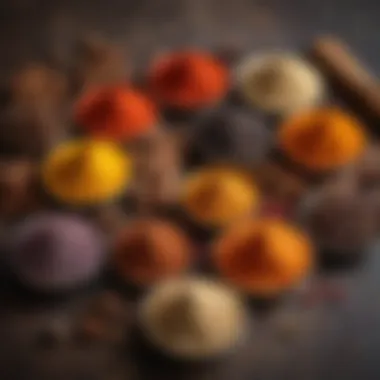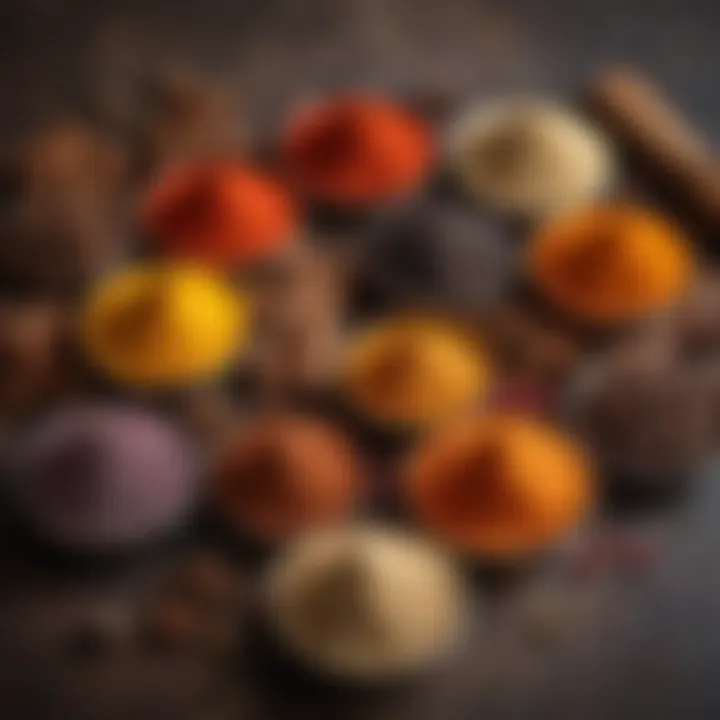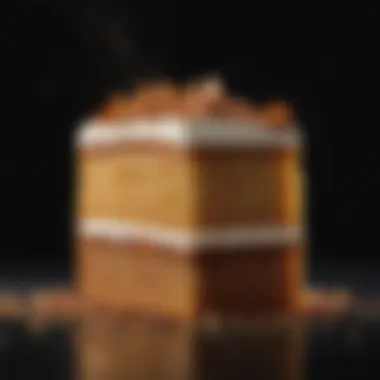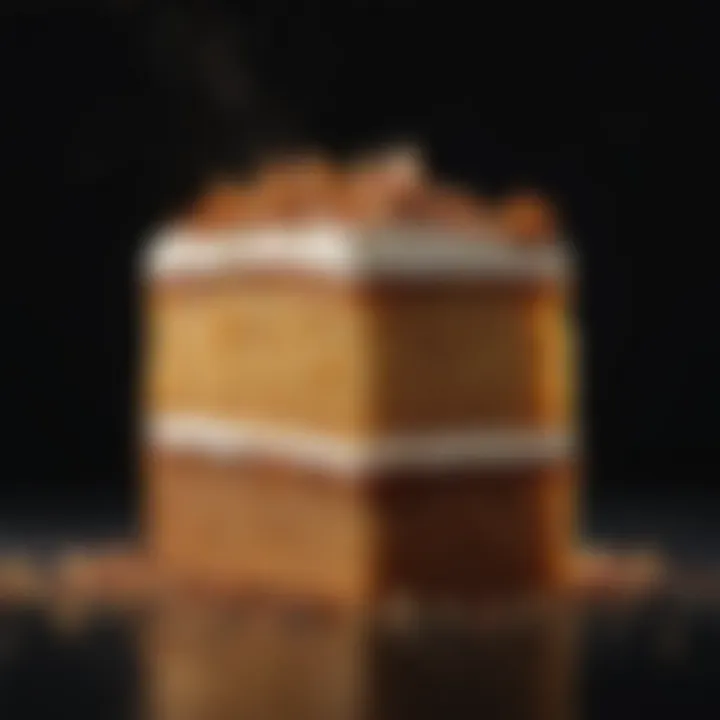Comprehensive Guide to Cake Spice Mix


Intro
The allure of cake spice mixes lies not only in their ability to enhance flavors but also in the rich tradition and history they embody. Understanding these blends provides insight into their significance in baking and how they can dramatically alter the outcome of your culinary projects. Many home bakers may not realize the depth of variation that a simple mix of spices can bring to a dish.
The use of spices in cakes is not new; it has roots that stretch back centuries. Various cultures have incorporated spices into their baking, each developing unique blends that are now staples in kitchens around the world. For example, the blend known as pumpkin pie spice, comprising cinnamon, nutmeg, ginger, and cloves, is a popular choice in North America during the autumn season.
As we explore cake spice mixes, we will cover several key areas, including the historical context of these blends, their composition, and practical applications in baking. Whether you are a novice or experienced cook, this guide aims to provide you with valuable knowledge. You will learn how to create personalized blends, discover effective storage solutions, and understand the impact spices have on flavor profiles and even health.
Read on to elevate your baking repertoire with insights into the wonderful world of cake spice mixes.
Prelims to Cake Spice Mix
Cake spice mixes are often overlooked in the culinary world, yet they hold significant value in enhancing cakes and other baked goods. Understanding their role can elevate the baking experience, making it not only more flavorful but also more enjoyable. From novice bakers to seasoned professionals, everyone can benefit from learning about the nuances of these spice blends.
Definition and Importance
A cake spice mix is a blend of spices commonly used in baking to add depth and warmth of flavor. These mixes typically include spices like cinnamon, nutmeg, ginger, and others, each contributing unique aromas and tastes. The importance of using a cake spice mix lies in its ability to transform a simple recipe into a rich, multi-dimensional treat. A well-crafted blend can enhance the flavor profile of a cake, making it more memorable and delicious.
"Spices are not just ingredients; they are the essence of flavor that can dictate the success of a dish."
Beyond simply adding taste, these spices play a crucial role in the baking process. They can influence texture, moisture content, and even the color of the final product. Furthermore, using a customized spice blend allows bakers to explore their creative sides, leading to unique and personal recipes.
Historical Overview
The use of spices in baking has a rich and varied history across cultures. Historically, spices were precious commodities. They were often traded and used as a currency. In medieval Europe, the addition of spices to food was a sign of wealth and sophistication. Cakes were often spiced with cinnamon and cloves, indicating their special status in celebrations and feasts.
In regions such as the Middle East, spices are integral to culinary traditions. Cardamom and nutmeg find their way into many desserts, shaping the flavor of cakes in ways distinct from Western palates. Such historical contexts provide insight into how cake spice mixes have evolved as recipes were adapted to local tastes and ingredient availability.
Over time, as trade routes expanded, so did the variety of spices utilized in cake making. Each culture adapted available spices to craft their own unique blends, influencing baking practices globally. This historical journey is essential to understanding how cake spice mixes became a staple in both home kitchens and professional bakeries today.
Ingredients in Cake Spice Mix
Understanding the ingredients in cake spice mixes is essential for achieving the desired flavor and aroma in baked goods. A balanced blend of spices can enhance a cake's overall character, making it more inviting and memorable. The right combination can elevate simple recipes into standout desserts. Whenever bakers create their own blends or choose pre-made mixes, knowledge of these ingredients ensures they select spices that complement each other.
Common Spices Used
Nutmeg
Nutmeg is a spice known for its warm and slightly sweet flavor. It is commonly used in cake spice mixes for its ability to add depth. The aromatic quality of nutmeg enhances flavors without overpowering the other ingredients. Its distinctive scent contributes to the overall baking experience. However, care should be taken as too much nutmeg can create a slightly bitter taste. Using nutmeg in moderation ensures its benefits shine without detracting from the dish.
Cinnamon
Cinnamon is perhaps the most well-known spice used in baking. Its sweet and woody flavor makes it a staple in many cake spice mixes. Cinnamon's versatility allows it to pair well with numerous ingredients, from fruits to chocolates. It adds warmth and a familiar taste that many find comforting. The unique characteristic of cinnamon is its ability to enhance sweetness in recipes. However, it's crucial to distinguish between Ceylon and Cassia cinnamon, as they have different flavor profiles and strengths.
Ginger
Ginger brings a fresh, zesty flavor that can enliven a cake mix. Its slight spiciness offers a unique contrast that balances sweeter flavors. Ginger is particularly valuable in cakes where a little kick is desired, such as gingerbread. Its presence can invigorate the overall taste. However, excessive ginger can overwhelm. A careful balance can provide the beneficial sharpness that elevates the final product.
Cloves
Cloves have a strong and distinct flavor, often used sparingly due to their potency. They contribute a warm and slightly sweet note to cake mixes. The aromatic, earthy essence of cloves provides depth and complexity in baked goods. It is particularly beneficial in spice blends aimed at robust and rich cakes. However, one disadvantage is that too many cloves can lead to a medicinal taste which might not appeal to everyone. Thus, moderation is key when incorporating cloves.


Allspice
Allspice is unique because it combines the flavors of cinnamon, nutmeg, and cloves. This makes it a powerful addition to cake spice mixes. The versatility of allspice allows it to infuse cakes with a depth of flavor and warmth. Its sweet and spicy tones enhance the overall profile of spices without overwhelming the dish. However, the distinctive flavor of allspice may not be to everyone's liking. Selecting the right amount will ensure it contributes positively to the mix.
Unique Variations
Cardamom
Cardamom offers a complex flavor profile that is sweet, spicy, and slightly floral. It is often used in spice mixes aimed at more exotic cakes. Cardamom’s unique contribution lies in its ability to add brightness to baked goods. Its unusual flavor is appealing for those looking to experiment with their baking. However, like other spices, it can be overwhelming if used in excess. Finding the right balance is essential when utilizing cardamom.
Vanilla
Vanilla is not a spice in the traditional sense, but it plays a crucial role in the flavor profile of cake mixes. Its sweet and creamy notes enhance the overall flavor, making it an indispensable ingredient. Vanilla extracts or pods contribute richness and a comforting aroma to cakes. It works well with other spices, amplifying their qualities rather than competing with them. However, the quality of vanilla is paramount, as synthetic versions may not yield the same effects.
Anise
Anise has a strong, sweet, and licorice-like flavor. It can be a divisive addition to cake spice mixes. Some enjoy its unique taste, while others may find it overpowering. Anise can add a layer of intrigue to baked goods. Its aroma and sweetness contribute positively when balanced with other flavors. Nevertheless, caution is advisable when incorporating it. Excessive use can dominate the flavor profile, detracting from the primary cake's taste.
Types of Cake Spice Mixes
Understanding the various types of cake spice mixes is essential for both novice and experienced bakers. Different spice mixes can dramatically influence the overall flavor and character of cake recipes. Knowing which blends to use enhances not only the taste but also helps to create distinctive culinary creations.
Classic Blends
Classic blends are the backbone of many cake recipes. They often include common spices like cinnamon, nutmeg, and ginger. These spices have been used for centuries in various baking traditions across cultures. Cinnamon is particularly favored for its versatility and warmth. It blends well with other spices, making it a staple in many cake spice mixes.
Using classic blends can simplify the baking process. They provide a reliable flavor profile that many people expect when it comes to cakes. For instance, ginger adds a warming note that complements the sweetness of cakes. This balance of flavors is especially valuable for seasonal baking during holidays, where the demand for traditional flavors increases.
Region-Specific Blends
Region-specific blends bring unique characteristics and flavors to baking. These blends reflect cultural heritages and local ingredient availability, leading to distinctive flavors. Understanding these blends can open up a range of possibilities for creativity in baking.
Middle Eastern Spice Mixes
Middle Eastern spice mixes often include a combination of cardamom, cinnamon, and cloves. These spices are not only aromatic but also contribute a rich depth to cakes. A key characteristic of Middle Eastern spice blends is their complexity. This complexity makes them an attractive choice for adventurous bakers looking to experiment with flavors.
The unique feature of these spice mixes is their ability to elevate simple cakes to sophisticated desserts. They can infuse traditional recipes with unexpected flavors. The advantage of using these mixes is their potential to surprise and delight those who taste your creations. However, it is essential to balance these spices, as they can easily overpower other flavors in sweet dishes.
European Cake Spices
European cake spices typically include cinnamon, vanilla and nutmeg. These spices have a long tradition in European baking, adding familiarity and comfort to cakes. A notable characteristic of European spice mixes is their focus on sweetness balanced with warm flavors. This makes them a popular choice in both home and professional kitchens.
The unique feature here lies in the combination of spices, which often emphasizes harmony over complexity. This balance creates a pleasing taste without overwhelming the palate. Furthermore, European spices tend to appeal to a broad audience, making them safer choices for gatherings. On the downside, their flavors might lack the exotic qualities that some bakers seek to introduce.
The choice of spice mix can transform a cake from ordinary to extraordinary, reflecting both the baker's creativity and the cultural influences of the ingredients used.
Creating Your Own Cake Spice Mix
Creating your own cake spice mix is a valuable skill for anyone who enjoys baking. It allows for customization based on personal preferences and dietary needs, enhancing the overall experience of preparing cakes. Moreover, it offers a way to experiment with flavors, leading to unique combinations that can set your baked goods apart. This section will outline key elements in developing personalized spice blends, providing guidance on how to optimize flavor profiles and ensuring the right measurements.
Choosing the Right Spices


The foundation of any effective cake spice mix lies in selecting the proper spices. It is crucial to consider the flavor notes of each spice and how they will interact with one another. Common choices like cinnamon, nutmeg, and ginger are popular because of their warm characteristics. However, venturing into lesser-known spices, such as cardamom or allspice, can add an unexpected twist.
When choosing spices, pay attention to the freshness and quality. Potent, fresh spices will produce a stronger, more vibrant flavor, which is essential for achieving a well-rounded mix. Consider mixing spices that complement one another. For instance, cinnamon pairs well with nutmeg, while ginger adds a zesty kick to classic blends. Experimentation plays a vital role here; don’t hesitate to create a small test batch.
Balancing Flavors
Balancing flavors is a key aspect of creating a harmonious cake spice mix. It involves ensuring that no single spice overpowers the others. Each spice has its unique strengths, and understanding these will guide you in determining the right proportions. Start with a dominate flavor, such as cinnamon, and then gradually add smaller amounts of stronger spices like cloves or allspice. This method allows for a controlled balance.
An effective practice is to keep a flavor diary. Document each new blend created, including the measurement ratios and the tasting results. This way, you can refine your mix over time, moving closer toward the desired taste. Remember the importance of subtlety; spices can build upon each other, creating a depth of flavor that elevates your baked goods.
Measurement Techniques
Accurate measurement is crucial in creating a cake spice mix. Using weight instead of volume often yields better results, as it accounts for variations in spice density. A simple kitchen scale can ensure consistent measurements every time.
Utilizing measuring spoons for small quantities can help maintain precise ratios. Mixing spices in small bowls before adding them to a big batch can reduce confusions and assist in achieving a smoother blend. Make note that aromatic spices such as cardamom can be potent; thus, a little amount may go a long way.
Finally, consider adjusting your measurements when it comes to personal tastes or recipes. Some may prefer a bolder flavor, while others might lean towards more subtle notes. Experimentation is the key to mastering your own cake spice mix.
"Creating your own spice mix empowers bakers to enhance their culinary creations, personalizing flavors to delight any taste preference."
Establishing an individual cake spice mix opens up a realm of possibilities in your baking journey. By selecting the right spices, balancing flavors effectively, and mastering the measurement techniques, you can craft blends that resonate not just with your palate but also with those who enjoy your creations.
The Role of Cake Spice Mix in Baking
In the culinary realm, cake spice mix serves a pivotal function in baking. It encapsulates a medley of flavors that not only intensify the taste of cakes but also enhance the overall sensory experience. Beyond mere flavor, cake spice mix contributes significantly to texture and aroma, enriching baked goods in multiple ways. Understanding these roles allows bakers to make informed decisions about their recipes, leading to more nuanced and delightful outcomes.
Enhancing Flavor Profile
The primary role of cake spice mix is to enhance the flavor profile of various baked goods. The unique combination of spices like cinnamon, nutmeg, and ginger creates a warm and inviting backdrop that complements sweet ingredients. Each spice brings its own character, introducing layers of complexity that a plain cake may lack.
- Cinnamon provides a sweet warmth.
- Nutmeg contributes a nutty richness.
- Ginger adds a subtle heat.
- Cloves impart a slightly sweet and pungent flavor.
When these spices blend together, they form a harmonious synergy that awakens the palette. The careful addition of cake spice mix can turn an ordinary cake into a memorable treat, capturing not just the taste but also the essence of the season. For instance, pumpkin spice mixes that include nutmeg and allspice create a flavor that is particularly beloved during the autumn months.
Moreover, the right balance of spices can help highlight other ingredients in the cake, making fruits, nuts, or chocolate stand out in a recipe. By skillfully adjusting the compositions of the spice mix, a baker can fundamentally alter the character of the cake itself, whether they are seeking a traditional flavor or a creative twist.
Affecting Texture and Aroma
Besides flavor, cake spice mix plays an essential role in affecting the texture and aroma of baked goods. The addition of spices introduces not just taste but also olfactory notes that elevate the overall enjoyment of the cake.
Aroma
The freshness and pungency of spices can transform the kitchen into a sensory delight. When baking, the aroma released by spices such as cardamom and cinnamon permeates the air, evoking nostalgia and comfort. These scents can stimulate appetite and enjoyment, making a cake more inviting from the moment it goes into the oven to when it is served.
Texture
On the texture front, spices can subtly influence moisture content and consistency. Certain spices absorb moisture differently, potentially leading to a denser cake or a lighter, fluffier texture, depending on the mix used. Using fresh ground spices, for example, can enhance the moisture-locking properties in batter, contributing to a cake that remains soft and tender.
Key Points:
- Spices enhance flavor complexity.
- The right blend can highlight other ingredients.
- Spices release inviting aromas during baking.
- Texture may be affected by moisture absorption of spices.


In summary, the role of cake spice mix represents a symbiotic relationship between taste, smell, and texture in baking. Bakers should carefully consider how these elements interact to achieve their desired outcomes. The art of blending spices is not only about balancing flavors but also about crafting an experience that tantalizes the senses from the first whiff to the last bite.
Storage and Shelf Life
The topic of storage and shelf life is crucial in maximizing the benefits of cake spice mixes. Spices can lose their potency over time, which can significantly affect the flavor and aroma of your baked goods. Understanding how to store these mixes properly ensures that you maintain their freshness and effectiveness. This section will explore ideal storage conditions and how to identify signs of deterioration.
Ideal Storage Conditions
To maintain the integrity of your cake spice mixes, you should adhere to specific storage practices. Proper storage not only preserves the flavor but also extends the shelf life of the spices. Here are a few guidelines:
- Keep in a Cool, Dry Place: Store your spice mixes in a cabinet away from heat sources and moisture. Humidity can lead to clumping and spoilage.
- Use Airtight Containers: Opt for glass jars with tight seals or plastic containers designed for spices. Exposure to air can diminish their potency.
- Avoid Direct Sunlight: Light can degrade spices, causing them to lose their flavors. A dark cupboard is ideal.
- Label and Date: Always label your containers with the name of the spice mix and the date it was prepared or purchased. This will help in monitoring freshness.
By following these practices, you enhance the longevity and usability of your cake spice mixes.
Signs of Deterioration
Recognizing when your spice mixes have deteriorated is essential for ensuring quality in your baking. There are several indicators that can help you determine whether it’s time to discard your cake spice mixes:
- Loss of Aroma: Fresh spices emit a strong, distinct aroma. If your spice mix smells stale or lacks fragrance, it has likely lost potency.
- Color Changes: Discoloration can signal that the spices are no longer fresh. A vibrant color typically indicates freshness, while dull or faded colors suggest aging.
- Clumping: If your spices are clumping together, it may be due to moisture absorption. This can lead to spoilage, so it's best to avoid using clumped mixes.
- Expiration Dates: While many spices do not have strict expiration dates, it's wise to adhere to any suggested periods on packaging. Generally, ground spices last about 2-3 years, while whole spices can last much longer.
By being aware of these signs, you can prevent baking with outdated spices, thereby ensuring the best possible outcome in your culinary creations.
Health Implications of Spices
The inclusion of spices in cake mixes does not only enhance flavor but also adds a layer of health benefits that can be important for both the baker and the eater. This section examines the nutritional aspects of these spices and highlights any potential allergens, providing a rounded view of their implications on health.
Nutritional Benefits
Spices found in cake mixes, such as cinnamon, nutmeg, and ginger, are not just aromatic; they also boast numerous health benefits. Here are some key nutritional influences of these spices:
- Cinnamon: Known for its ability to help regulate blood sugar levels, cinnamon contains antioxidants. It may also have anti-inflammatory properties.
- Nutmeg: This spice offers a good source of essential oils and can help with digestion. Nutmeg also possesses antimicrobial properties, which can aid the body's overall health.
- Ginger: Often used for its digestive benefits, ginger can alleviate nausea and provide anti-inflammatory advantages. It is also rich in antioxidants.
- Cloves: A potent antioxidant, cloves can promote oral health and may also contain compounds that have anti-cancer properties.
These spices can contribute to overall health when used appropriately. They may assist in managing various health issues and enhancing the nutritional profile of cakes.
Potential Allergies and Considerations
While spices can be healthful, it is essential to consider any potential allergies or adverse reactions they may cause. Here are some critical points to keep in mind:
- Allergic Reactions: Some individuals may experience allergic reactions to specific spices. Cinnamon and nutmeg are less common allergens but can still trigger reactions in sensitive individuals.
- Interference with Medications: Certain spices, such as ginger, can interact with medications. For instance, ginger can act as a blood thinner, potentially affecting those on anticoagulants.
- Dosage: The amount of spice used is significant. High doses may lead to adverse effects rather than benefits. Thus, moderation is key.
- Pregnancy Considerations: Pregnant individuals should consult healthcare providers regarding spice consumption. Some spices might not be advisable in large quantities during pregnancy.
In summary, although cake spice mixes can offer numerous advantages to health, awareness of allergies and potential interactions with medications is necessary. This ensures that the enjoyment of baked goods remains safe and beneficial.
The End
In concluding our exploration of cake spice mix, it is pertinent to reflect on its significance within the culinary landscape. The cake spice mix offers not only a way to enhance flavors in baked goods but also imbues personal creativity into one’s cooking. With the right blend, even simple ingredients can transform into memorable dishes.
Summary of Key Points
- Historical Significance: The origins of spice mixes have deep roots, often linked to cultural practices and traditions across the globe. Understanding their background provides insight into why certain spices were selected for baking.
- Essential Ingredients: Common spices, like cinnamon and nutmeg, play a pivotal role in flavor development. Knowing which spices to use can dramatically change the taste of a cake.
- Health Aspects: Many spices offer nutritional benefits. Being aware of these can further motivate the use of spice mixes, balancing flavor and health.
- Storage and Longevity: Proper storage techniques ensure that spice mixes retain their potency, keeping flavors intact for many bakes to come.
Final Thoughts on Cake Spice Mix
Cake spice mix is more than just a collection of flavorful powders. It represents a fusion of tradition and innovation in baking. Customizing blends to suit personal taste allows for artistic expression.
As home bakers, the opportunity to experiment exists. Whether modifying classic recipes or creating new one's, cake spice mixes can enrich culinary experiences. The journey through spices is an exciting one, leading to delightful outcomes in the kitchen.
"The art of baking fulfills on many levels – it captivates with smell and taste, but it also serves as an avenue for exploration and creativity."
For food lovers of all ages, mastering the use of cake spice mixes is essential. Embrace the nuances, learn from history, and experiment with your blends. Your baking will undoubtedly reflect the depth of your culinary understanding.







